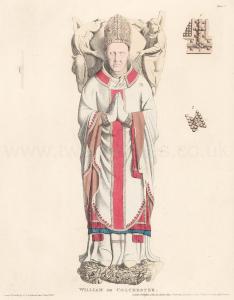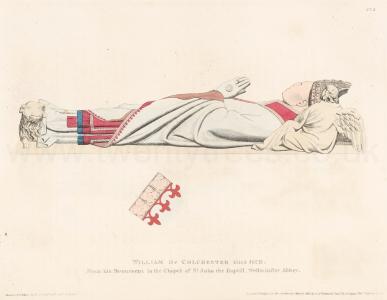Effigy of William of Colchester
Effigy of William of Colchester is in Monumental Effigies of Great Britain.
BECAME a monk of Westminster in 1360. He was much engaged in the affairs of his convent, and was employed from 1377 to 1379 in managing a law-suit instituted in the Papal Court by the Abbey of Westminster, against the Dean and Canons of St. Stephen's. For his good service in this matter, he was allowed a chamber and garden to himself, a yearly salary of six marks, a corrody, or monk's allowance, over and above this provision; and he was to be treated in all respects as one of the senior monks. He was at Rome again, on the same or some other business for his convent, in 1384. In 1391 he was sent abroad on a mission for King Richard the Second, but on what occasion is not known. In 1399 he was one of the Commissioners appointed to receive the resignation of the Crown from King Richard the Second. Widmore, the historian of Westminster Abbeya, discredits the statement that he was concerned in 1400 in a plot against the life of King Henry the Fourth, as a forgery of a later day.
Note a. Inquiry into the first Foundation of Westminster Abbey. London, 1743, p. 110.
In 1408 he was at Pisa, in Italy, owing, it is supposed, to a schism then occurring in the Papacy. On the 20th March, 1423, Henry the Fourth being taken ill while at his devotions in the Abbey, was carried to a large apartment belonging to the Abbot's house, (then inhabited by William of Colchester,) the celebrated Jerusalem Chamber [Map], probably so called from some painting, which, according to the fashion of the time, decorated its lambruscated or wainscotted walls. The story related by the continuator of the History of Croyland, that the King believed this circumstance to be an accomplishment of a prophecy that he should die at Jerusalem, is become trite by the lines of Shakspeare —
"Bear me to that chamber; there I'll die;
In that Jerusalem shall Harry die."
And there he actually breathed his last.
In 1414 Abbot Colchester was one of the King's ambassadors to the Council of Constance. Towards the latter period of his life we may suppose him to be much engaged in rebuilding the west part of the Abbey, towards which undertaking Henry the Fifth gave yearly 1,000 marks. He died in October 1420, having held the office of Abbot thirty-four years: a longer period than any of his predecessors. He was buried in the chapel of St. John the Baptist [Map], in his church; in the tomb on which his effigies are sculptured, without other inscription than the letters W. C. on the pillow under his head. Details.
Plate I. 1. Front of the Abbot's mitre. (The Abbey of Westminster was privileged with the pontifical ornaments; in other words, a mitred abbey.) 2. Jewelled border of the cape of the chasuble. Plate II. Profile. Border of the chasuble.

